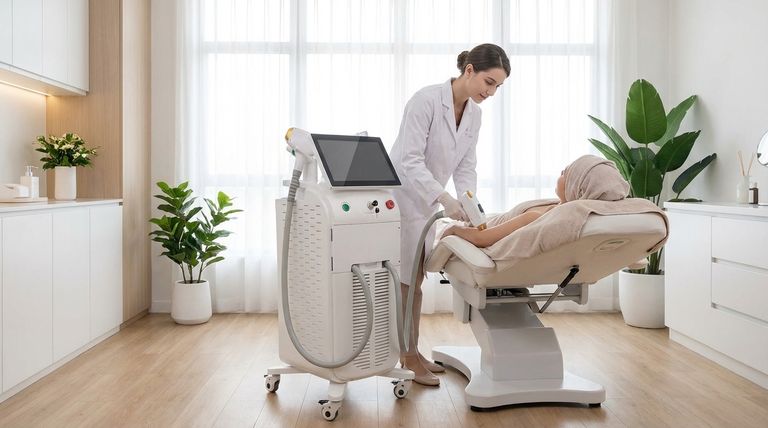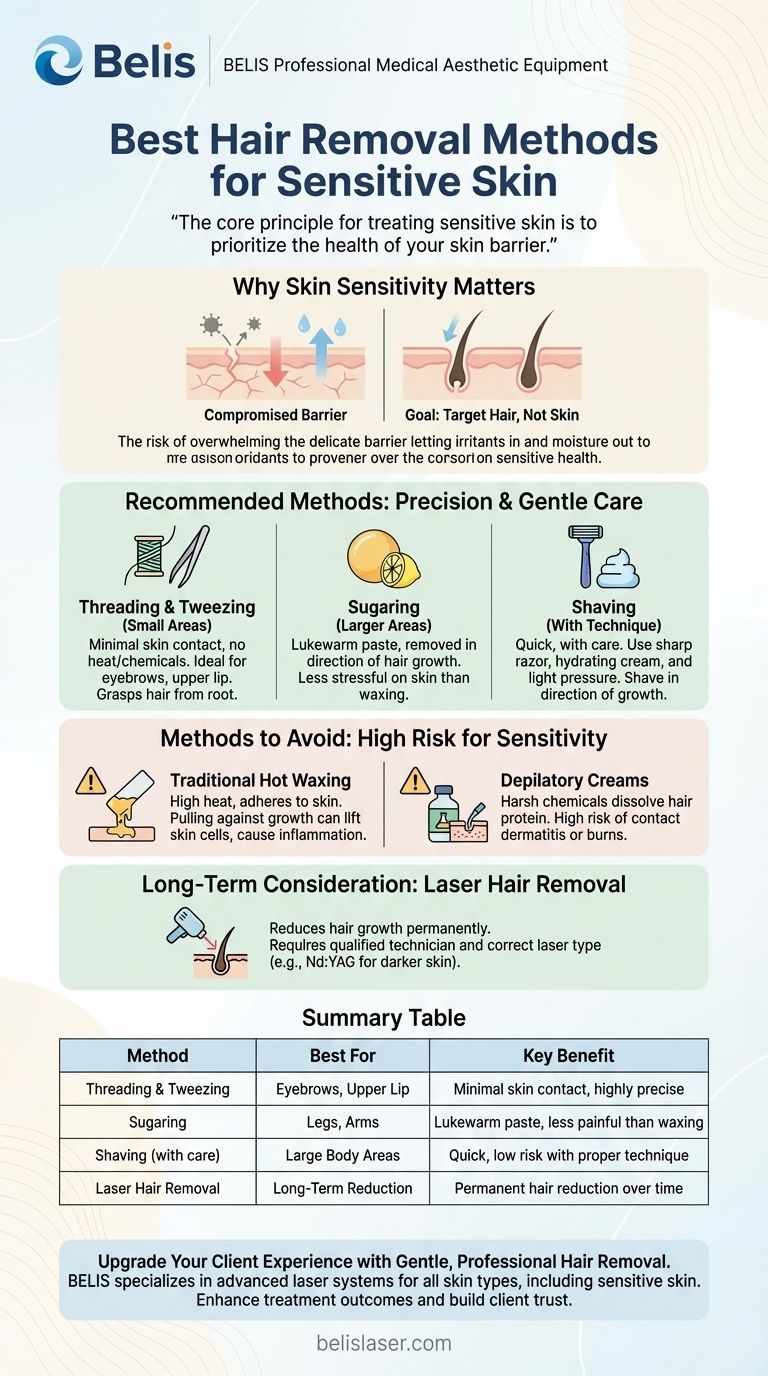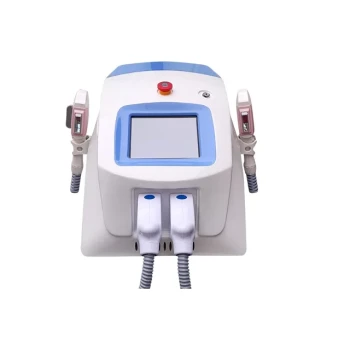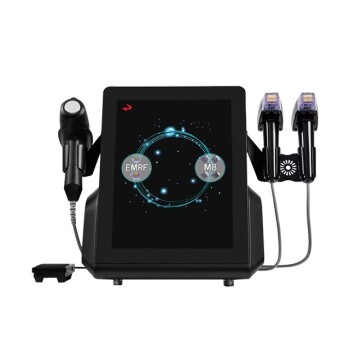For sensitive skin, the best hair removal methods are those that minimize direct contact and irritation to the skin's surface. Threading and plucking are often considered ideal because they target individual hairs directly without extensively pulling or applying chemicals to the surrounding skin, significantly reducing the risk of inflammation and redness.
The core principle for treating sensitive skin is to prioritize the health of your skin barrier. The best hair removal method is not universal; it is the one that removes the hair effectively while causing the least amount of trauma to the surrounding tissue.

Why Skin Sensitivity Dictates Your Method
Understanding the Sensitive Skin Barrier
Sensitive skin often has a compromised barrier function. This means it's less effective at retaining moisture and protecting itself from external irritants.
Standard hair removal techniques can easily overwhelm this delicate barrier, leading to common reactions like prolonged redness, bumps (folliculitis), rashes, or even chemical burns.
The Goal: Target the Hair, Not the Skin
The fundamental goal is to isolate the hair removal action to the hair follicle itself. Any method that involves friction, harsh chemicals, or excessive heat applied broadly across the skin poses a higher risk of triggering a reaction.
A Breakdown of Hair Removal Options
Threading & Tweezing: The Precision Approach
As the most targeted methods, threading and tweezing (plucking) are excellent for small, delicate areas like the eyebrows and upper lip.
These techniques grasp the hair shaft and pull it from the root. Because the tool or thread makes minimal and brief contact with the skin, the potential for irritation is dramatically lowered. They do not involve heat or chemicals.
Sugaring: A Gentler Alternative to Waxing
Sugaring uses a simple paste made of sugar, lemon, and water that is applied at a lukewarm temperature, reducing the risk of burns.
Crucially, the sugar paste is removed in the direction of hair growth. This leads to less stress on the skin and a lower chance of hair breakage and ingrown hairs compared to traditional waxing.
Shaving: Success is in the Technique
Shaving cuts the hair at the skin's surface. While it can cause irritation, proper technique makes it a viable option for larger areas.
Always use a sharp, clean razor and a hydrating, fragrance-free shaving cream or gel to create a protective barrier. Shave with light pressure in the direction of hair growth to minimize razor burn and nicks.
Understanding the Trade-offs and Methods to Avoid
The High Risk of Traditional Waxing
Traditional hot waxing is often problematic for sensitive skin. The high temperature can cause inflammation, and the wax adheres firmly to the top layer of the skin.
When the strip is pulled against the direction of hair growth, it can not only be painful but can also lift skin cells, leading to significant irritation and damage to an already fragile skin barrier.
The Chemical Dangers of Depilatory Creams
Depilatory creams use strong chemicals, such as thioglycolic acid, to dissolve the protein structure of the hair.
For sensitive skin, these chemicals can be extremely harsh, often causing contact dermatitis or chemical burns. A patch test is absolutely essential, but even then, widespread use can be too aggressive.
Laser Hair Removal: A Long-Term Consideration
Laser hair removal can be an excellent long-term solution, as it reduces hair growth permanently and thus eliminates the need for frequent removal. However, the procedure itself can cause temporary redness and sensitivity.
Success depends on using the correct type of laser for your skin tone (e.g., Nd:YAG for darker skin) and ensuring it is performed by a qualified, experienced technician.
Making the Right Choice for Your Goal
To select the best method, consider the area you are treating and your long-term objective.
- If your primary focus is small, delicate areas like the face: Threading or tweezing offers unparalleled precision with minimal skin irritation.
- If your primary focus is larger body areas like legs or arms: Careful shaving with proper technique or professional sugaring are the safest and most effective options.
- If your primary focus is a long-term reduction in hair growth: Consult a board-certified dermatologist to see if you are a good candidate for laser hair removal.
Ultimately, protecting your skin's health is the most important factor in your hair removal journey.
Summary Table:
| Method | Best For | Key Benefit |
|---|---|---|
| Threading & Tweezing | Eyebrows, Upper Lip | Minimal skin contact, highly precise |
| Sugaring | Legs, Arms | Lukewarm paste, less painful than waxing |
| Shaving (with care) | Large Body Areas | Quick, low risk with proper technique |
| Laser Hair Removal | Long-Term Reduction | Permanent hair reduction over time |
Upgrade Your Client Experience with Gentle, Professional Hair Removal
For medical aesthetics clinics and premium beauty salons, offering safe and effective hair removal treatments is essential for client retention and satisfaction. BELIS specializes in professional medical aesthetic equipment, including advanced laser systems designed for all skin types, including sensitive skin.
Our technologies help you:
- Deliver comfortable, effective treatments with minimal client discomfort.
- Expand your service menu with trusted, professional-grade solutions.
- Enhance treatment outcomes and build client trust.
Contact our experts today to find the perfect hair removal solution for your practice and provide the exceptional care your clients deserve.
Visual Guide

Related Products
- Diode Tri Laser Hair Removal Machine for Clinic Use
- Trilaser Diode Hair Removal Machine for Beauty Clinic Use
- Clinic Use IPL and SHR Hair Removal Machine with Nd Yag Laser Tattoo Removal
- IPL SHR Hair Removal Machine for Permanent Hair Removal
- Clinic Diode Laser Hair Removal Machine with SHR and Trilaser Technology
People Also Ask
- What is the best way to remove hair from sensitive areas? A Guide to Pain-Free, Irritation-Free Results
- How can I maximize my laser hair removal results? A Guide to Optimal Treatment and Safety
- How to get better results from laser hair removal? Achieve Smooth, Long-Lasting Hair Reduction
- Who is not suitable for laser hair removal? A Safety Guide to Assess Your Candidacy
- Does laser hair removal tighten your skin? The Truth About Collagen and Hair Removal



















